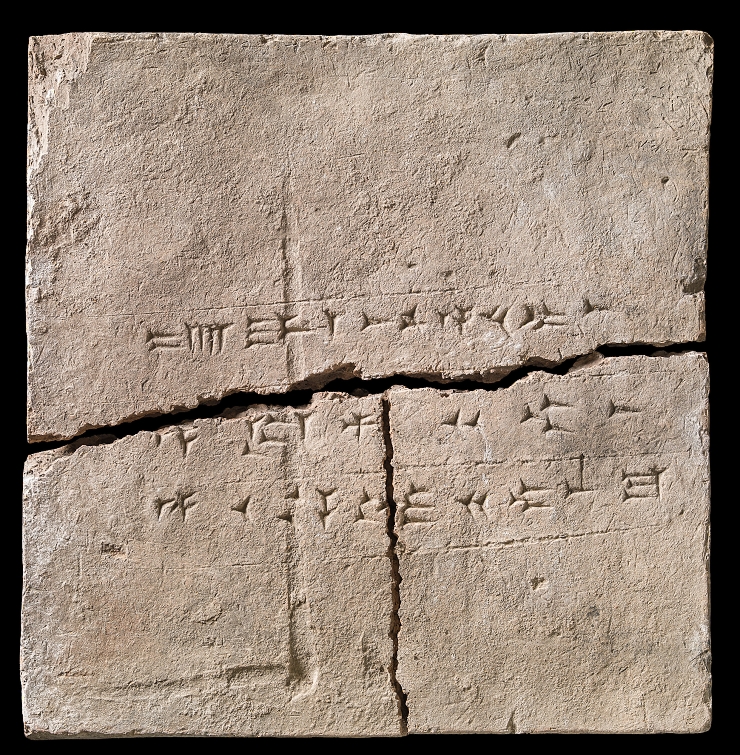Teda to označení muselo být pracný. Nestrávil s tím ten cihlář víc času, než s výrobou té cihly? I když nejspíš už tenkrát měli dělbu práce v manufakturním stylu. Někdo míchal bahno, druhý tomu dával tvar a třetí tisknul. Podle těch rysek to nevypadá, že by nápis válečkovali nebo tiskli v celku.
What plants did the bricks contain three thousand years ago? The first ever DNA analysis answered
Categories: Nálezy nejenom s detektorem na blízkém východě
Near the Tigris River at the ancient city of Kalhu (now Nimrudu), a brickmaker once prepared clay bricks for the construction of a new palace for King Ashurnasirpal II. Little did he know that 2,900 years later it would serve as a unique time capsule revealing details of the flora of that specific area and time through the examination of DNA preserved in the brick over thousands of years. Nothing like this had ever been done before.
The clay brick has belonged to the Danish National Museum since 1958. It was discovered during the British excavation of Nimrud in early 1949. Danish archaeologists also took part in the excavation and brought back several donated items, including the brick in question, in 1958. However, the brick did not survive transport to Denmark in one piece, and was broken horizontally. During handling in 2020, the lower half of the brick unfortunately broke vertically. However, this event became an opportunity for a scientific study of the still uncontaminated parts of the clay inside the brick.
The brick was recovered from the Northwest Palace of the Neo-Assyrian king Ashurnasirpal II (883 - 859 BC) in the ancient city of Kalhu in the north of present-day Iraq. A cuneiform inscription in Akkadian identifies it as "Property of the Palace of Ashurnasirpal, King of Assyria", narrowing the date of the brick's manufacture to the years 879 to 869 BC. The clay used to make the brick comes from the mud on the banks of the Tigris River. It was then mixed with plant materials and animal dung. It was then shaped, inscribed with a wedge-shaped inscription in Akkadian and dried in the sun. Bricks with cuneiform inscriptions were traditionally used for the construction of monumental royal buildings in ancient Mesopotamia from the late 3rd to the late 1st millennium BC.
Many terms for the flora of ancient Mesopotamia are known to scholars from texts of the second and first millennia BC. The writings provide a considerable amount of information about agricultural products and ingredients used in medical prescriptions, pharmaceutical mixtures, and various rituals. Earlier work comparing modern plant names with ancient words has focused primarily on identifying related words in Arabictina, Aramaic, and Hebrew, although such an approach has limited potential to link ancient terminology to precise biological species.
New research using DNA provides a partial solution to overcome the problems associated with attempts to identify specific plant taxonomic groups using linguistics. The study identifies the presence of specific families of ancient flora in a given region over a limited period of time. As a result, the results are more accurately compared with Akkadian terms for ancient flora. It also provides an overview of the influence on the domestication history of specific plants.
Using aDNA extraction and sequencing from the clay brick and subsequent data analysis, the researchers were able to detect 34 uniquetaxonomic groups of plants representing the order Laurales, as well as seven distinct families from other orders: Apiaceae (Myrrhaceae - subfamily Apioideae, phylum Selineae), Betulaceae (Birchaceae), Brassicaceae (Brassicaceae - including the genus Brassica), Ericaceae (Heath - including the subfamilies Ericoidae and Vaccinioideae), Poaceae (lichens - tribe Poeae and Triticeae), Fagaceae (beeches - genus Quercus) and Salicaceae (willows). The most abundant plant sequences were from the families Brassicaceae (mustard, cabbage) and Ericaceae (heather). Also Betulaceae (birch), Lauraceae (laurel), Selineae and Triticeae (cultivated grasses).
Once the main ancient Assyrian royal city, Kalhu has been at the forefront of scientific interest since 1845, when Sir Austen Henry Layard conducted the first excavations there. The information gathered formed the basis for much of the knowledge about the so-called "cradle of civilization" that shaped later Assyriology. The site has been repeatedly and regularly explored, including by the eminent British archaeologist Max Mallowan and his wife and the famous detective novelist Agatha Christie. In 2014, the remains of the Northwest Palace were destroyed by members of ISIS.
A video overview of the monuments of Nimrud before their destruction
Roman Nemec
Sources: thehistoryblog.com, nature.com

A broken brick with a cuneiform inscription

The yellow square on the left of the image represents the piece of brick shown on the right with five sampling points for analysis

Lamassu guard from the palace entrance gate - Wikipedia
The article is included in categories:



